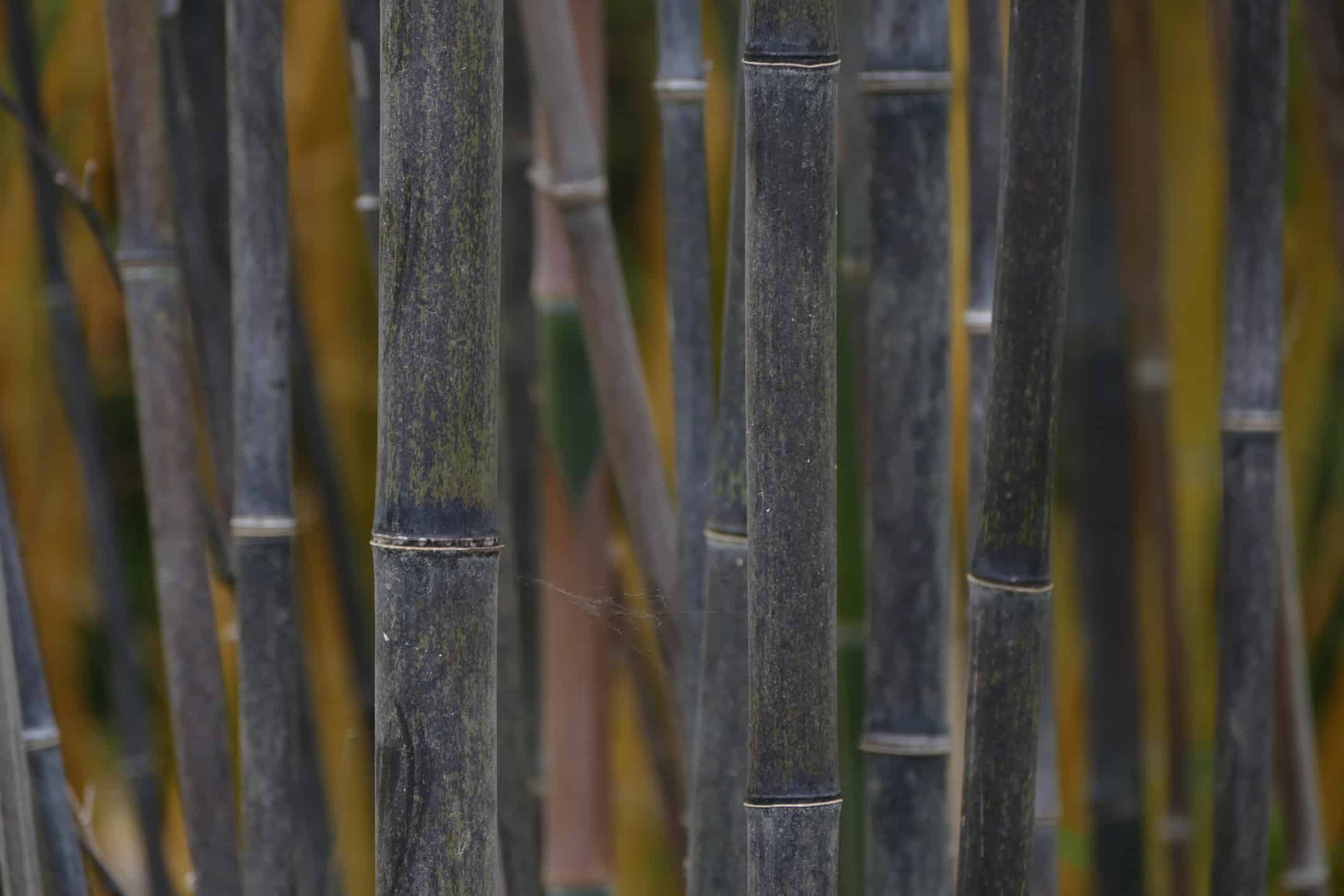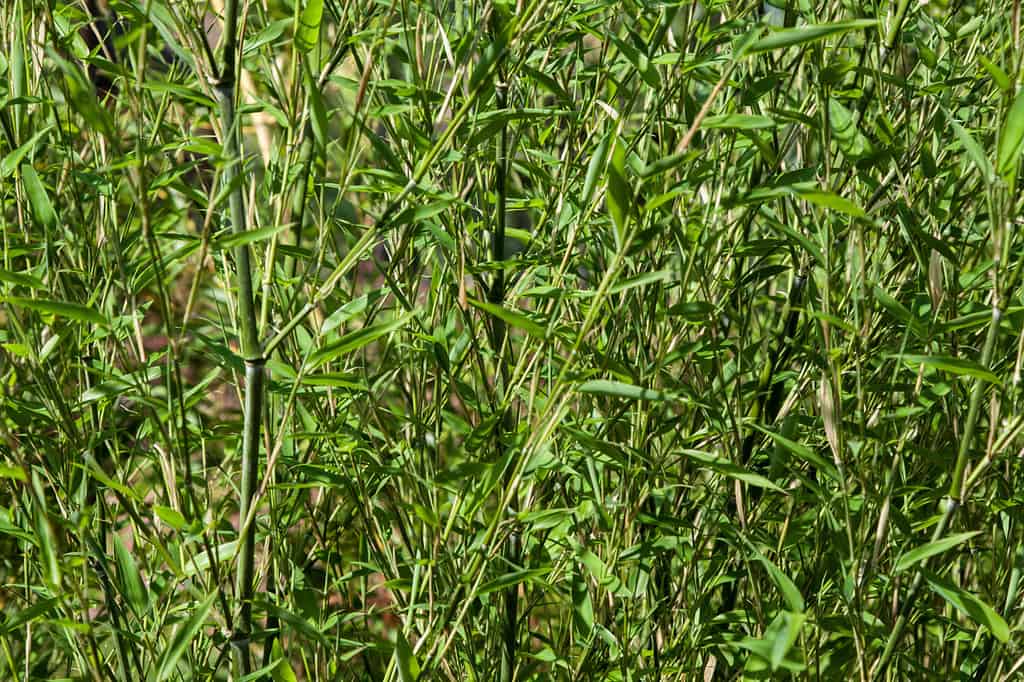Adding an exotic touch to your Colorado garden or landscaping can be accomplished with the presence of bamboo. Bamboo is a remarkable plant that can thrive in various environments, including the western state’s unique climate. And with over 1,000 bamboo species in the world, the challenge will be picking just one! So, we wanted to help you get started on your journey toward growing bamboo in Colorado. Below are a handful of species that will do well in the state and some detailed tips for planting, caring for, and protecting bamboo during winter.

Black bamboo (
Phyllostachys nigra) will happily grow in some parts of Colorado. Make sure to check the hardiness zone of any bamboo before purchasing it to make sure it is compatible with your region.
©iStock.com/Jannick Tessier
Varieties of Bamboo to Grow in Colorado
Most people think of the soaring mountains when they picture Colorado. But the state has an incredibly diverse range of environments. There is also plains and desert on either side of the Rockies. And the range of USDA Hardiness Zones extends from 3 to 7, depending on which part of the state you live in. Unfortunately, if you live in Zone 3, you will need to opt for a smaller bamboo species to keep indoors. Those living in other parts of the state can enjoy outdoor bamboo, provided they select one suitable to the area. Here are a few to consider.
1. Golden Bamboo (Phyllostachys aurea)
This visually striking variety features stunning golden-yellow culms that can reach heights of 20-30 feet. It is well adapted to any of Colorado’s many climates. But it is also renowned for its rapid growth, making it a fantastic choice for gardens and landscapes. Golden bamboo thrives in Zones 4a to 10b.
2. Black Bamboo (Phyllostachys nigra)
Black bamboo is a captivating variety known for its mesmerizing dark culms. They create a striking contrast against surrounding plants. It can grow up to 20 feet tall and makes the ideal windscreen. The only issue with black bamboo is that it grows best in Zones 7 to 10, which restricts its Colorado growing regions. However, if you live in one of the warmer areas, feel free to add this stunner to your outdoor space.
3. Bissett’s Bamboo (Phyllostachys bissetii)
Bissetii bamboo is an exceptional choice for Colorado due to its cold-hardy nature. It thrives in Zones 5 to 10 and can tolerate cold down to -10° F.
It has dense foliage and an elegant appearance. Since it grows to an average height of 20 to 25 feet and has a dense canopy, it is an ideal option for creating beautiful privacy screens or hedges.
4. Green Screen Bamboo (Fargesia robusta)
If you have limited space, Fargesia robusta is the perfect choice. This clumping bamboo only averages 12 feet tall and is non-invasive. So it is suitable for smaller gardens. Its lush green foliage creates a dense and attractive screen. And green screen bamboo thrives in Zones 7 to 9, making it perfect for the warmer Colorado regions.
5. Yellow Groove Bamboo (Phyllostachys aureosulcata)
This vibrant variety boasts distinctive yellow culms adorned with green stripes, providing a dynamic and lively addition to any landscape. It can grow up to 30 feet tall but averages about 25 feet high.
However, the best part is that it grows well in Zones 4a to 11b. So most of Colorado can enjoy this beauty!
6. Temple Bamboo (Semiarundinaria fastuosa)
Temple bamboo is a cold-hardy variety that showcases captivating blue-green culms. Reaching heights of up to 35 feet, it can withstand Colorado’s winter conditions. It is a reliable choice for Colorado residents hoping to grow a giant privacy or windscreen. Temple bamboo is cold-hardy down to -5º F and grows best in Zones 6b to 10.

Golden bamboo will grow in every part of Colorado and makes a fantastic wind or privacy screen.
©Phuwadon Phichairat/Shutterstock.com
Planting and Caring for Bamboo in Colorado
In many respects, growing plants (including bamboo) in Colorado is fairly straightforward. But the area does have to cope with high winds, summer heat, and brutally cold winters. So it is vital to understand how to properly care for your new bamboo plant before putting it in the ground.
Location
Selecting the appropriate location for your bamboo is crucial to ensure its successful growth. Bamboo thrives in areas with full to partial sun exposure. However, some will do ok in slightly shaded areas. Once you settle on a species (or two), take a moment to check its preferred sun level. That will save you time and grief later on.
Opt for an area that provides ample space for the bamboo’s anticipated height and spread, allowing it to flourish without causing any structural issues to nearby buildings.
Soil
Bamboo prefers well-draining soil with a slightly acidic to neutral pH level. Prepare the soil by incorporating organic matter such as compost. This step will help improve drainage and fertility. The challenge in Colorado is avoiding heavy clay soils that retain excess moisture. This soil can hinder the growth and overall health of the bamboo. If your ground is more clay-based, add extra compost and consider amending the area with something like perlite.
Planting Bamboo
The planting process is critical for establishing healthy bamboo growth. Start by digging a hole that is twice as wide and deep as the bamboo’s root ball. Place the root ball in the hole, ensuring the bamboo goes into the ground at the same depth as it was in the container. Refill the hole with soil, pressing down gently. Then, water the bamboo thoroughly to settle the soil and provide essential hydration for the newly transplanted bamboo.
Watering
Adequate watering is crucial, especially during the establishment phase. Deep, infrequent watering is the best way to encourage robust root growth. Aim for approximately 1-2 inches of water per week. Keep the soil evenly moist but not waterlogged. Pay closer attention to the watering schedule during the hot summer months to avoid stressing the root system.
Controlling Spread
Bamboo has a reputation for its rapid spread. So implementing effective measures to control its growth is essential. One of the best solutions is to install a physical barrier around the planting area. A high-density polyethylene (HDPE) sheet should get inserted at least 30 inches deep into the ground to prevent rhizomes from escaping. Take care to extend the barrier above the soil surface since rhizomes like to escape up as well.
Pruning and Maintenance
Regular pruning and maintenance will help maintain the desired shape and prevent overgrowth. Regularly remove any dead or damaged canes by cutting them close to the ground. This process helps improve the overall aesthetics and health of the bamboo.
Additionally, thinning out dense clumps improves airflow and lets the sunlight get in. Prune in late winter or early spring before new growth emerges. Doing so will ensure the bamboo has ample time to recover before the growing season.
Winter Protection
Colorado’s harsh winter conditions can pose a challenge to bamboo. Thankfully, some quick and easy steps will help protect your new plants. Before the temperature drops too much, apply a thick layer of organic mulch around the base of the bamboo. Mulch serves as insulation, protecting the roots from extreme cold. It also helps the soil retain moisture.
You may also want to wrap the canes with burlap or fleece during severe cold snaps. It isn’t entirely necessary. But this step will provide an extra layer of protection against freezing temperatures and wind damage.

Not all bamboo is enormous. Some species are better suited for ground cover or container planting.
©Ketta/Shutterstock.com
Thank you for reading! Have some feedback for us? Contact the AZ Animals editorial team.








